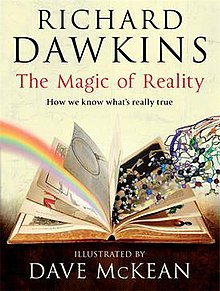The Magic of Reality
 |
|
| Author | Richard Dawkins |
|---|---|
| Illustrator | Dave McKean |
| Country | United Kingdom |
| Language | English |
| Subject | Science |
| Publisher |
Bantam Press (UK) Free Press (US) |
|
Publication date
|
15 September 2011 (UK) 4 October 2011 (US) |
| Media type | Print (hardcover), Paperback, Audiobook, iPad app |
| Pages | 272 |
| ISBN | |
| OCLC | 709673132 |
| LC Class | Q173 .D255 2011 |
| Preceded by | The Greatest Show on Earth: The Evidence for Evolution |
| Followed by | An Appetite for Wonder: The Making of a Scientist |
The Magic of Reality: How We Know What's Really True is a 2011 book by the British biologist Richard Dawkins, with illustrations by Dave McKean. The book was released on 15 September 2011 in the United Kingdom, and on 4 October 2011 in the United States.
It is a graphic science book aimed primarily at children and young adults. Dawkins has stated that the book is intended for those aged around 12 years and upwards, and that when trialling the book prior to publishing, younger readers were able to understand its content with additional adult assistance.
The book is published in the United Kingdom by Bantam Press, and in the United States by Free Press.
In the first chapter of the book, Richard Dawkins explains what he means with the title The Magic of Reality:
Magic is a slippery word: it is commonly used in three different ways, and the first thing I must do is distinguish between them. I'll call the first one 'supernatural magic', the second one 'stage magic' and the third one (which is my favourite meaning, and the one I intend in my title) 'poetic magic'. [...] What I hope to show you in this book is that reality – the facts of the real world as understood through the methods of science – is magical in this third sense, the poetic sense, the good to be alive sense. [...] In the rest of this book I want to show you that the real world, as understood scientifically, has magic of its own – the kind I call poetic magic: an inspiring beauty which is all the more magical because it is real and because we can understand how it works. Next to the true beauty and magic of the real world, supernatural spells and stage tricks seem cheap and tawdry by comparison. The magic of reality is neither supernatural nor a trick, but – quite simply – wonderful. Wonderful, and real. Wonderful because real.
Most chapters begin with brief re-tellings of creation myths that emerged as attempts to explain the origin of particular observed phenomena. Dawkins selects these myths from throughout the world, including Babylonian, Judeo-Christian, Aztec, Maori, Ancient Egyptian, Australian Aboriginal, Nordic, Hellenic, Chinese, Japanese, and other traditions. Chapter 9 ("Are we alone?") includes contemporary alien-abduction mythology; Chapter 4 ("What are things made of?") omits mythology altogether as Dawkins says that really small phenomena were unknown to primitive peoples prior to the invention of advanced optical magnification equipment, any texts they believed to be divinely inspired having failed to mention such useful knowledge as beyond human experience at the time. Dawkins also revisits his childhood and recalls his initial thoughts on these various phenomena or those thoughts expressed by his young contemporaries. Dawkins gives his critique of many of the myths, such as when he points out that much mythology involves some god's symbolic transgressive act performed just once, with Dawkins saying that such one-time acts would be inadequate to explain the mechanism as to why the phenomena continue to happen in unbroken cycles.
...
Wikipedia
